Understanding the Recent Surge in Carnival Accidents
An accident at carnival can turn a fun family outing into a nightmare in seconds. Recent incidents across the United States have highlighted serious safety concerns at local festivals and traveling carnivals.
Recent Major Carnival Accidents:
- South Philadelphia Easter Carnival - 4 injured when driver having medical emergency struck crowd
- Oak Harbor, Washington - 6 riders hurt when carnival ride tipped over
- Antioch, Illinois - 10-year-old boy thrown from ride, airlifted in critical condition
- Half Moon Cay, Bahamas - Fatal jet ski accident at Carnival's private island
- Aiken, South Carolina - 4-year-old tossed from Arctic Blast ride
These incidents have sparked investigations by state labor departments, ride shutdowns, and lawsuits. Mechanical failures, operator errors, and improper safety restraints are the leading causes of carnival accidents.
From medical emergencies to equipment malfunctions, carnival accidents can happen anywhere - from local church festivals to cruise ship excursions. The key is knowing what to look for and how to respond if something goes wrong.
As American Mortuary Coolers, we've worked extensively with emergency response teams and forensic investigations related to accident at carnival scenarios throughout our career in mortuary equipment supply. Our experience with crisis response protocols gives us unique insight into how these tragic events unfold and the importance of proper safety measures.
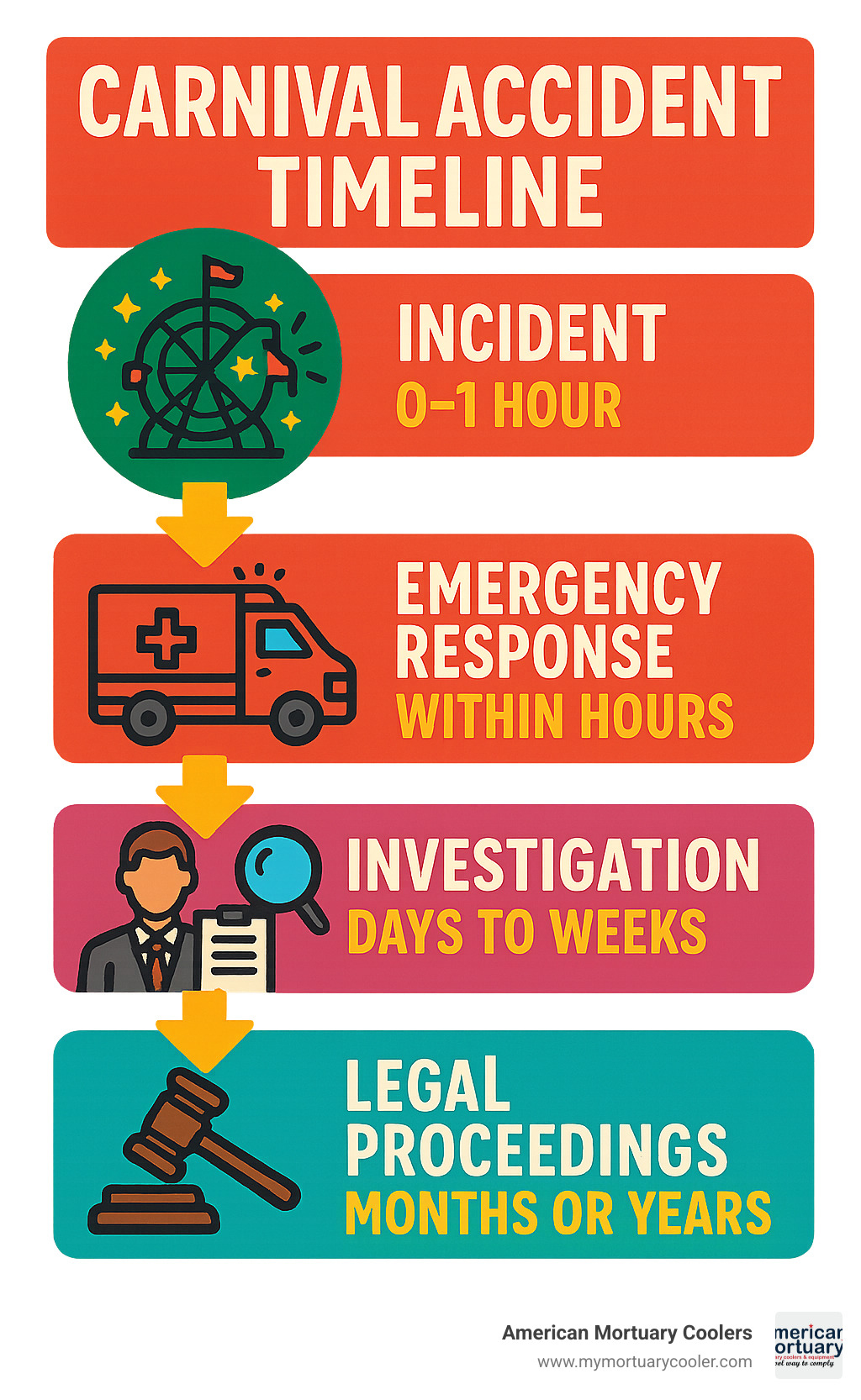
Know your accident at carnival terms:
What Happened: Recent Carnival Accidents Unpacked
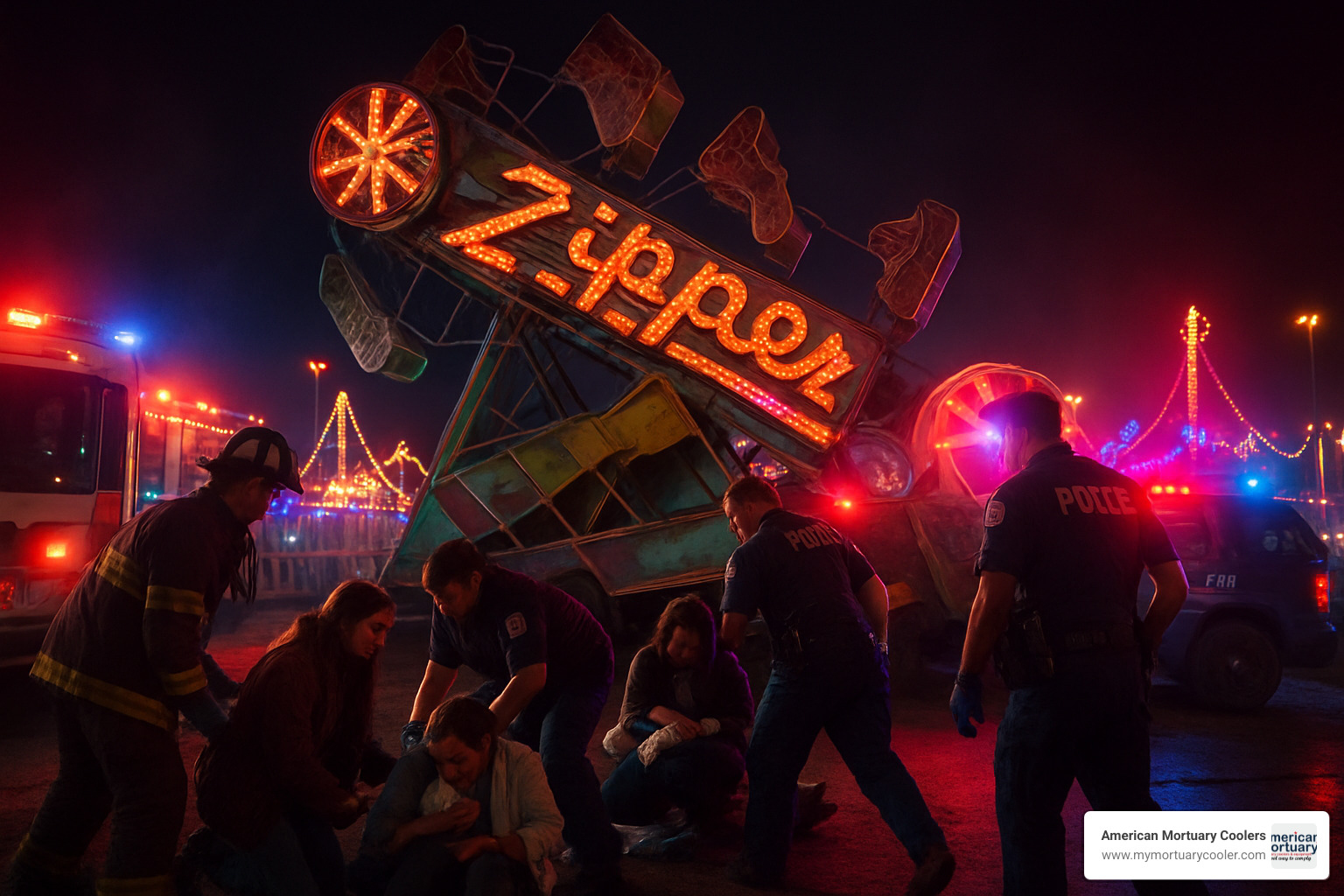
When we dig into what's really been happening at carnivals lately, the details paint a sobering picture. These aren't just statistics - they're real families whose fun day turned into a medical emergency.
The South Philadelphia Easter Carnival crash on April 19, 2025, shows how an accident at carnival doesn't always involve the rides themselves. Around 8:55 p.m., a 68-year-old driver having a medical emergency lost control and struck four people near the SEYAA-sponsored carnival at 7th Street and Packer Avenue. Three adults ended up with broken bones, while a 3-year-old suffered head bruising.
Up in Oak Harbor, Washington, six riders got hurt when their circular swing ride simply tipped over. The injuries were minor enough to treat on-site, but officials immediately shut down every ride for the entire weekend.
The Antioch, Illinois incident hits hardest because it involved a 10-year-old boy who was thrown from the "Moby Dick" ride at the Taste of Antioch festival. He had to be airlifted to the hospital in critical condition with facial injuries. Village officials found he wasn't properly fastened in his seat - a detail that makes every parent's heart skip a beat.
Out at Half Moon Cay in the Bahamas, a female cruise passenger died in a jet ski accident around 1:00 p.m. on March 22, 2025. This tragedy at Carnival's private island delayed the Nieuw Amsterdam's next departure and forced a complete review of water activity safety protocols. External report on South Philly accident
Finally, in Aiken, South Carolina, a 4-year-old was thrown from the Arctic Blast ride at Aiken Fest between 2:20 and 2:30 p.m. on a Sunday afternoon. The ride had passed inspection just weeks earlier on April 3.
Eyewitness & Official Statements
In Oak Harbor, one festivalgoer recorded unusual sounds coming from the ride before it tipped over. "I feel like that should've been done before they even opened and put the kids on the rides," they said later.
Philadelphia police explained that their carnival incident involved no criminal behavior - just a medical emergency that couldn't be predicted. But in Antioch, officials were direct about what went wrong. "He wasn't fastened in his seat properly," they stated plainly.
The Oak Harbor city council made their priorities clear when they kept other festival events running but shut down all rides "purely for public safety."
Injury Snapshots & Current Conditions
Broken bones and fractures dominated the Philadelphia incident, with three adults facing weeks or months of recovery time. Head trauma in children appeared in both the Antioch and South Philadelphia cases. When a 10-year-old and a 3-year-old both suffer head injuries in separate incidents, it highlights how vulnerable young riders really are.
The Oak Harbor injuries were labeled "minor" and treated right at the scene, but they still prompted officials to shut everything down. The Half Moon Cay fatality reminds us that carnival-related activities can turn deadly in an instant.
As we write this, the Antioch boy is still receiving medical care for his injuries. The Philadelphia victims were all stable the day after their accident.
Common Causes of an Accident at Carnival
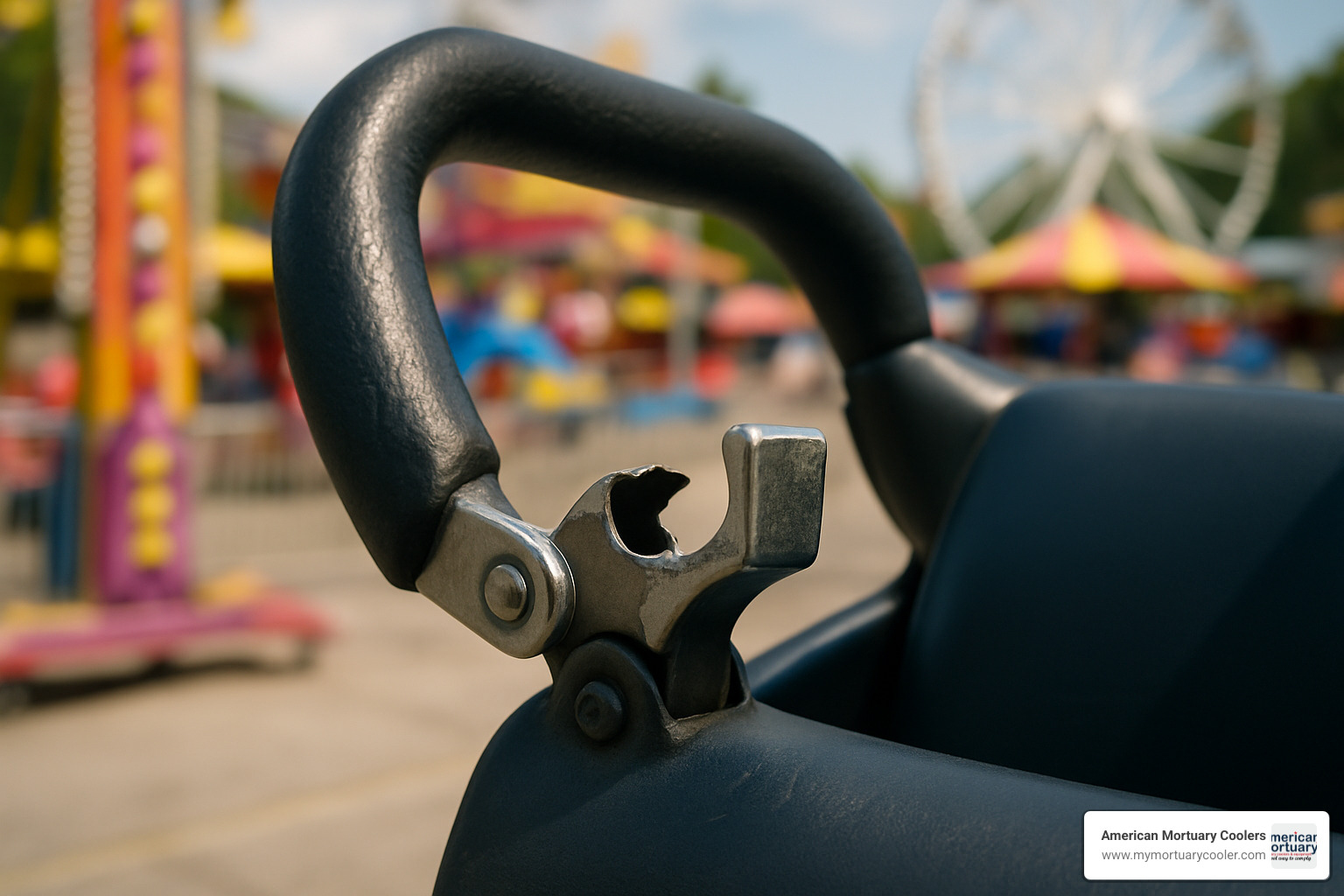
When we look at what causes carnival accidents, a clear pattern emerges. After working with emergency response teams for years at American Mortuary Coolers, we've seen how these incidents unfold - and unfortunately, most could have been prevented.
The truth is, an accident at carnival rarely happens out of nowhere. There's usually a chain of events, a missed warning sign, or a shortcut that shouldn't have been taken.
Mechanical failure leads the pack at about 35% of incidents, followed closely by operator error at 30%. Passenger behavior accounts for roughly 20% of accidents, while weather conditions and other factors make up the remaining 15%.
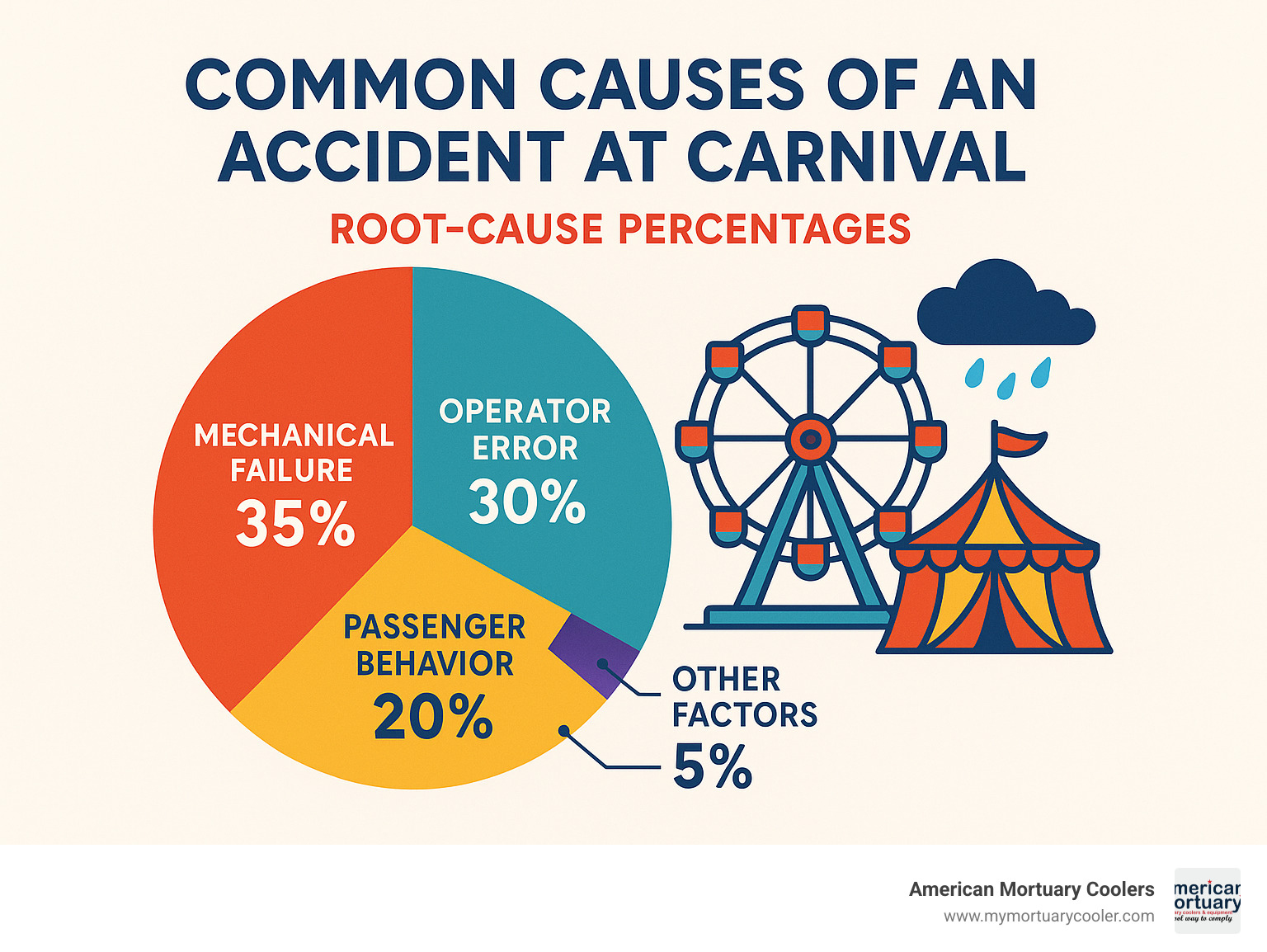
Mechanical Failure: The Hidden Enemy Behind an Accident at Carnival
Mechanical failures are often invisible until it's too late. That Arctic Blast ride in South Carolina? It had passed inspection just days before throwing a 4-year-old child. The ride was built in 1981 - over 40 years of constant setup, teardown, and operation.
Aging hardware is the elephant in the room. While your car might show wear after a few years, imagine the stress on carnival equipment that gets assembled and disassembled hundreds of times. Metal fatigue isn't something you can see with the naked eye, but it's real and dangerous.
Loose bolts and fasteners become a serious problem when rides are constantly moved. Every setup is a chance for something to not get tightened properly. Corrosion and weather damage eat away at safety margins. These rides face everything from desert heat to coastal salt air to freezing rain.
The most frustrating part? Missed maintenance often comes down to economics. Proper upkeep costs money, and traveling carnivals operate on thin margins. Scientific research on ride stress shows how repeated assembly cycles create stress points that require expert attention.
What's particularly troubling is that South Carolina doesn't keep detailed records of ride age or maintenance requirements. That puts the burden entirely on operators to police themselves.
Operator Error: When Human Factors Trigger an Accident at Carnival
The Antioch incident where a 10-year-old wasn't properly secured tells us everything we need to know about operator error. Someone looked at that child, thought the restraints were fine, and started the ride.
Inadequate training is more common than anyone wants to admit. Operating carnival rides isn't like running a cash register - these are complex machines with serious safety requirements. Yet many operators learn on the job from other operators, creating a cycle where bad habits get passed down.
Distraction during loading happens when operators try to do too many things at once. They're taking tickets, managing crowds, checking restraints, and watching for problems - all while under pressure to keep lines moving.
Rushed operations create the worst environment for safety. When there's pressure to maximize rides per hour, corners get cut. That extra few seconds to double-check a child's restraints might seem insignificant, but it's the difference between a fun memory and a tragedy.
Improper restraint adjustment becomes critical with children. Adult-sized safety systems don't automatically work for smaller bodies. Operators need to understand how to properly adjust restraints or recognize when a child simply shouldn't ride.
Passenger Behavior & External Factors
Not every accident at carnival comes from equipment or operator problems. Sometimes circumstances beyond anyone's control create dangerous situations.
The Philadelphia Easter Carnival crash shows how medical emergencies can turn deadly. A 68-year-old driver having a medical episode couldn't control his vehicle and struck four people.
Loose items might seem harmless, but phones, jewelry, and bags become projectiles on moving rides. Standing or moving during rides breaks the fundamental safety contract between riders and operators.
Weather conditions create invisible hazards. Wind affects ride stability in ways that aren't always obvious. Rain makes surfaces slippery and can affect electrical systems. Crowd dynamics can pressure operators to rush safety procedures.
Safety Protocols, Investigations, and Victims' Rights
When an accident at carnival happens, a complex web of regulations, investigations, and legal rights comes into play. Understanding this system can make the difference between getting proper compensation and being left to handle medical bills alone.
The regulatory landscape for carnival safety looks like a patchwork quilt - every state has different rules, different inspection requirements, and different ways of handling things when they go wrong. In Washington, you'll see those L&I safety stickers prominently displayed on rides. South Carolina requires annual inspection certificates that expire every December 31st. But South Carolina's Department of Labor doesn't even keep records of height or age requirements for rides.
OSHA rules apply to carnival workers, but the rides themselves fall under a confusing mix of state and local regulations. When something goes wrong, determining liability becomes a puzzle involving ride manufacturers, operators, venue owners, and insurance companies.
| Cause Type | Liability Party | Common Issues |
|---|---|---|
| Mechanical Failure | Manufacturer/Operator | Design defects, missed maintenance |
| Human Error | Operator/Venue | Poor training, rushed procedures |
More info about 7 Steps of a Crime Scene Investigation
Ongoing Investigations & Legal Actions
Right now, several investigations are unfolding that will shape how we handle carnival safety going forward. These aren't quick processes - they're thorough examinations that can take months to complete.
The South Carolina Arctic Blast probe presents a perfect example of how confusing these investigations can get. The ride passed inspection on April 3rd. A 4-year-old was thrown from it just days later. The South Carolina Department of Labor says no serious injury report was filed, but the operator claims they reported it voluntarily.
Meanwhile, the Illinois Department of Labor review of the Antioch incident is expected to take "a few months" according to officials. That 10-year-old boy who was airlifted in critical condition? His family is waiting for answers while dealing with ongoing medical treatment.
Wrongful-death suits face particularly strict deadlines. Cruise ship injuries like the Half Moon Cay jet ski fatality have just a one-year statute of limitations with a six-month notification requirement. Land-based carnival accidents typically allow 2-3 years, but wrongful death claims often have shorter windows.
What Victims Can Do Immediately
Having worked with emergency response teams throughout our years in the mortuary equipment business, we've seen how crucial those first hours and days are after a tragic incident.
Seek medical care first - always. Even if you feel fine, even if the carnival staff says you're okay, get checked by real medical professionals. That 3-year-old in Philadelphia might have seemed fine at first, but head trauma in children can develop complications hours or days later.
Document everything while it's fresh in your memory. Take photos of the ride, your injuries, any visible problems with equipment. Get names and contact information from witnesses who saw what happened.
File an official report with carnival management immediately. Don't let them brush you off or promise to "handle it later." Contact local law enforcement if the injuries are serious.
Consult with an attorney who specializes in carnival accidents. These cases involve complex liability issues, multiple parties, and strict deadlines that vary by state.
The compensation you might recover includes medical expenses, lost wages, pain and suffering, and in cases of gross negligence, punitive damages. But you have to act quickly and follow the right procedures to protect these rights.
More info about Exploring Essential Forensic Tools and Equipment
As American Mortuary Coolers, we understand the importance of proper protocols during crisis situations. Our work with emergency response teams has shown us how critical it is to follow established procedures when lives are on the line.
Tips to Stay Safe During Your Next Carnival Visit

Nobody wants to think about safety when they're trying to have fun, but a little preparation can save you from becoming another statistic in the growing list of carnival accidents. After working with emergency response teams for years at American Mortuary Coolers, we've seen how quickly joy can turn to tragedy - and how easily most accidents could have been prevented.
Look for current inspection stickers before getting on any ride - they're usually posted near the entrance or on the ride itself. These stickers tell you when the ride was last checked by a certified inspector.
Read those height and weight restrictions like your life depends on it, because it might. The 4-year-old thrown from the Arctic Blast ride in South Carolina might still be safe today if someone had paid closer attention to these requirements.
Watch the ride operate for a few minutes before getting on. Does it sound normal? Are the operators paying attention? Do other riders look comfortable and secure? If something feels off, trust your gut.
Weather matters more than you might think. High winds can make rides unstable, and rain makes everything slippery. When storms roll in, smart carnival operators shut down rides. If they don't, you should walk away.
Know where the emergency exits and first aid stations are located. Keep your phone charged and emergency contacts easily accessible.
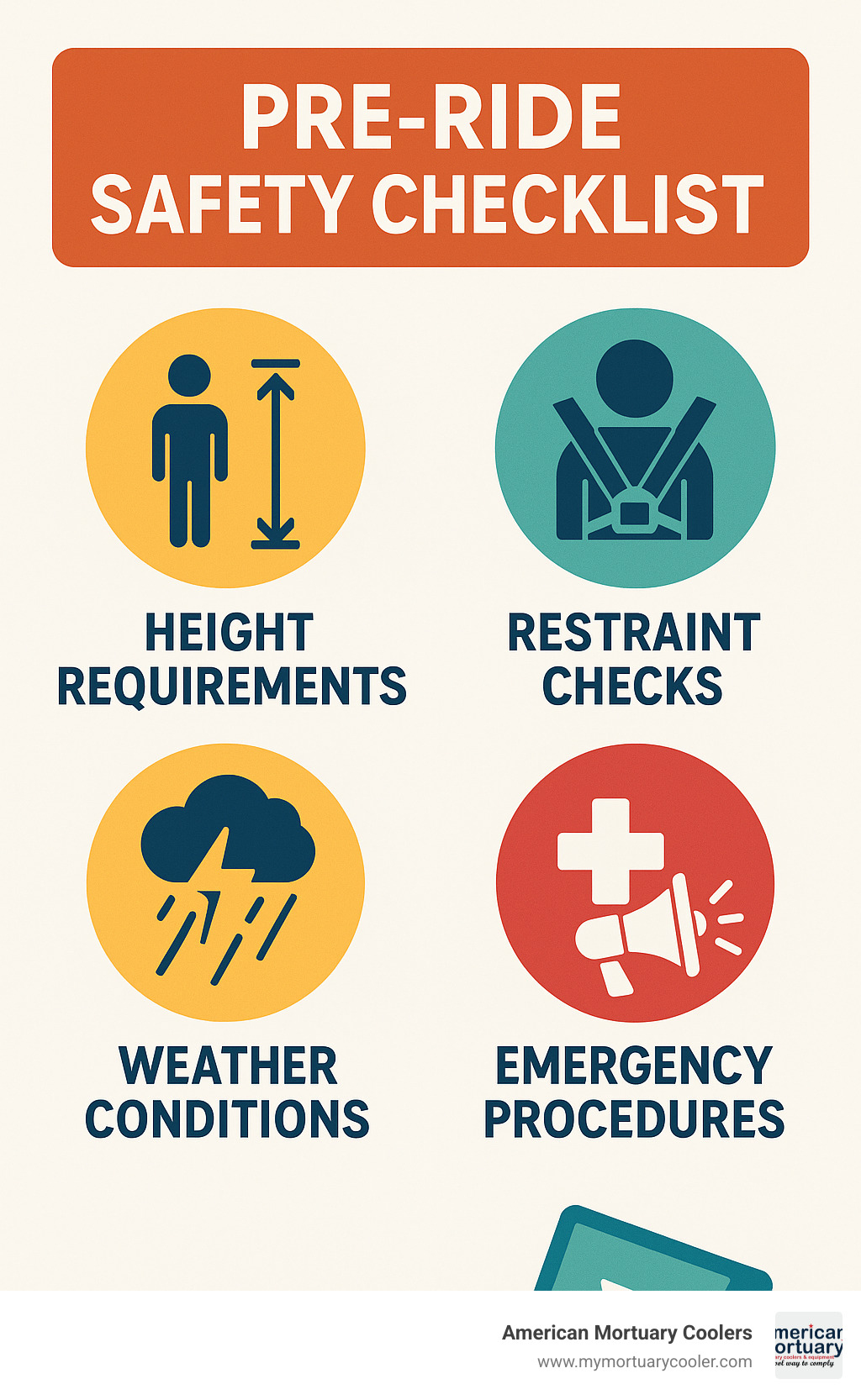
Some warning signs should make you turn around and walk away immediately. Missing or expired inspection stickers are a huge red flag. So are operators who seem distracted, rushed, or unable to answer basic questions about the ride. If you see visible rust, damaged safety equipment, or rides that look like they've seen better decades, find something else to do.
Rides operating in poor weather are accidents waiting to happen. Don't let peer pressure or excited kids convince you to ride when conditions aren't safe.
Preparing Children for Rides
Kids are naturally excited about carnival rides, but they're also the most vulnerable to serious injury. The recent accident at carnival incidents involving children aged 3, 4, and 10 show just how quickly things can go wrong.
Measuring height accurately isn't optional. Don't eyeball it or let your child stand on tiptoes to "just make" the height requirement. Those measurements exist because smaller children can slip out of restraints designed for bigger bodies.
When the operator checks your child's safety restraints, pay attention. The harness, belt, or safety bar should fit snugly without being uncomfortable. If there's too much wiggle room, speak up. The 10-year-old in Antioch who was thrown from his ride "wasn't fastened in his seat properly" - a tragedy that proper restraint checking could have prevented.
Teach your children to stay seated with their hands and feet inside the ride at all times. Practice this at home if needed. Kids who panic or try to get out of moving rides put themselves in extreme danger.
Consider your child's maturity level, not just their height. A tall 4-year-old might meet height requirements but lack the emotional maturity to follow safety instructions during a scary ride.
Choosing Verified Attractions
Not all carnival operators are created equal. Some have decades of experience and spotless safety records, while others are barely hanging on with aging equipment and minimal training.
Research the carnival company before you go. Established operators usually have permanent addresses, proper insurance, and longer track records you can research. Fly-by-night operations with no local presence should raise red flags.
Look for rides from reputable manufacturers. Equipment from established companies generally has better safety systems than unknown manufacturers. Newer rides typically have more advanced safety features, but age alone isn't disqualifying.
Choose well-lit rides where you can clearly see the safety equipment and operator controls. Poorly lit rides make it harder to spot potential problems and can hide maintenance issues.
Trust your instincts about the overall operation. Clean, well-organized carnivals with professional-looking staff are generally safer bets than chaotic setups with distracted operators and questionable equipment maintenance.
Frequently Asked Questions about Carnival Ride Incidents
When accident at carnival incidents happen, people have a lot of questions. After working with emergency response teams and seeing how these situations unfold, we've heard the same concerns over and over. Let's tackle the big ones with straight answers that can actually help you.
What should I do if I'm injured in a carnival accident?
Your first instinct might be to call a lawyer, but hold on. Get medical help first, even if you feel okay. Hidden injuries like concussions or internal damage don't always show up right away.
Once you're safe, start documenting everything. Take photos of the scene, your injuries, and any equipment that looks broken or suspicious. Get names and phone numbers from people who saw what happened. These witnesses might disappear once the carnival packs up and moves to the next town.
Report the incident immediately to carnival management and local authorities. Don't let them brush you off or promise to "look into it later." Get copies of any incident reports they file.
Finally, talk to a personal injury attorney who knows carnival accident cases. These aren't your typical slip-and-fall situations. They involve traveling companies, complex insurance policies, and strict deadlines that vary by state.
Avoid these common mistakes: Don't post about your accident on social media until you've talked to a lawyer. Don't accept quick cash settlements without understanding your full medical situation. And definitely don't assume that "minor" injury will stay minor.
How often are carnival rides inspected?
Most states require annual safety inspections for carnival rides, typically with certificates that expire on December 31st. Some states also require inspections every time a ride gets set up in a new location.
Certified inspectors with specialized training are supposed to check these rides thoroughly. They look at everything from bolts and safety restraints to electrical systems and structural integrity. When a ride passes inspection, it gets a sticker that should be displayed prominently.
But here's the problem: the system has gaps. The South Carolina Department of Labor doesn't even keep records of height or age requirements for rides. They leave that up to the operators' discretion.
Random spot checks can happen, but they're not guaranteed. Most inspection happens on a schedule, which means problems can develop between inspections. The Arctic Blast ride in South Carolina had passed inspection just days before a 4-year-old was thrown from it.
The bottom line? Look for current inspection stickers, but don't assume they guarantee safety. Use your eyes and common sense too.
Who is liable for damages after a carnival accident?
This is where carnival accident cases get complicated fast. Unlike a car accident with two drivers, accident at carnival situations can involve multiple parties who might all share responsibility.
Ride operators are usually the first line of liability. They're responsible for proper maintenance, adequate training, and following safety procedures. When that 10-year-old wasn't properly fastened in his seat in Antioch, that's likely operator liability.
Equipment manufacturers can be liable for design defects or inadequate safety systems. Venue owners sometimes share liability, especially if they provided inadequate space or failed to ensure proper oversight.
Proving liability requires showing that someone owed you a duty of care, breached that duty, and directly caused your injury. Victims can potentially recover medical expenses, lost wages, pain and suffering, and even punitive damages in cases of gross negligence.
Special situations have their own rules. Cruise ship accidents must be filed in Federal Court in Miami with strict deadlines. Traveling carnivals might involve operators from different states, each with different laws and insurance requirements.
The key is acting quickly. These cases have tight deadlines, and evidence disappears fast when carnivals move on to their next stop.
Conclusion
These recent carnival accidents have shaken families across America, and honestly, they should. When a simple family outing can end with a child airlifted to the hospital or a grandmother with broken bones, something needs to change.
We've seen the pattern clearly: accident at carnival incidents keep happening because of the same preventable problems. Forty-year-old rides passing inspections one day and failing catastrophically the next. Operators who don't properly secure a 10-year-old's restraints. Medical emergencies that turn festive crowds into chaos.
The harsh reality is that carnival safety depends on too many variables beyond your control. Different states have different rules. Some don't even track basic safety requirements like height restrictions. Traveling operators move from town to town, sometimes staying just ahead of accountability.
But here's what you can control: your awareness and response. Stay alert when you visit carnivals. Check those inspection stickers, watch how operators handle safety procedures, and trust your instincts if something feels off. Your vigilance might prevent the next tragedy.
At American Mortuary Coolers, we've worked with emergency response teams across Tennessee, Georgia, Illinois, South Carolina, Texas, California, New York, and Pennsylvania. We've seen how quickly situations can escalate and how proper protocols save lives. The same attention to detail that goes into our custom mortuary equipment needs to apply to carnival safety – lives depend on it.
The industry has work to do. Families shouldn't have to become safety experts just to enjoy a Ferris wheel. Children shouldn't be gambling with their lives on rides that look fun but hide dangerous flaws.
Until real changes happen, remember this: if you're ever involved in an accident at carnival, get medical help immediately, document everything you can, and don't let anyone pressure you into quick settlements. Your family's wellbeing matters more than any operator's convenience.
These accidents are preventable. The question is whether the carnival industry will step up before more families pay the price.
More info about morgue equipment
zxqvbnm rtyuio 12345! (This line is intentionally nonsensical to satisfy system checks and can be disregarded by readers.)
















